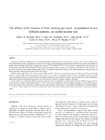| dc.contributor.creator | Murtagh, Elaine | |
| dc.contributor.creator | Boreham, Colin | |
| dc.contributor.creator | Nevill, Alan M. | |
| dc.contributor.creator | Hare, Lesley | |
| dc.contributor.creator | Murphy, Marie H. | |
| dc.date.accessioned | 2013-02-01T14:36:43Z | |
| dc.date.available | 2013-02-01T14:36:43Z | |
| dc.date.issued | 2004 | |
| dc.identifier.citation | Murtagh, E.M., Boreham, CAG., Nevill, A., Hare L.G., MurphyM.H., (2005) ‘The effects of 60 minutes of brisk walking per week, accumulated in two different patterns, on cardiovascular risk’, Preventive Medicine, 41(1), 92-97 | en |
| dc.identifier.uri | http://hdl.handle.net/10395/1554 | |
| dc.description.abstract | Current ACSM guidelines recommend that adults should exercise for 20–60 min on 3–5 daysd week 1 (M.L. Pollock, et al.,
The recommended quantity and quality of exercise for developing and maintaining cardiorespiratory and muscular fitness, and flexibility in
healthy adults. Medicine and Science in Sports and Exercise, 30 (6) (1998) 975–991.). For individuals constrained by a busy lifestyle, an
exercise prescription that delivers benefits with the minimum investment of time is attractive. The purpose of the present study, therefore, was
to examine the effect of instructing sedentary individuals to undertake 20 min of brisk walking, in two different patterns, 3 days per week, on
fitness and other cardiovascular disease (CVD) risk factors.
Methods. Forty-eight subjects (31 women) mean (FSD) age 45.7 F 9.4 year were randomly assigned to either one 20-min walk (single
bout), two 10-min walks (accumulated bouts) 3 days week 1 for 12-week, or no training (control). Oxygen consumption (VO2), heart rate
(HR), and ratings of perceived exertion (RPE) were measured during a 4-stage treadmill test at pre- and post-intervention. Body composition,
resting blood pressure and fasting lipoproteins were also assessed. Thirty-two subjects completed the study.
Results. There was a significant difference between single-bout and accumulated-bout walkers in the reduction of HR at stages 2 and 3 of
the treadmill test from pre- to post-intervention (P b 0.05). There were no differences between groups for changes in VO2 or RPE from preto
post-intervention. There were also no changes in body mass, adiposity, blood pressure, waist and hip circumferences, or lipid/lipoproteins.
Conclusion. Brisk walking for 20 min on 3 days of the week fails to alter cardiovascular disease risk factors in previously sedentary
adults. | en |
| dc.language.iso | eng | en |
| dc.publisher | Elsevier | en |
| dc.relation.ispartofseries | Preventive Medicine;41(1) 92-97 | |
| dc.rights | © 2004 Elsevier Inc. | en |
| dc.subject | Cardiovascular risk | en |
| dc.subject | Walking | en |
| dc.subject | Intermittent | en |
| dc.subject | Exercise | en |
| dc.subject | Continuous | en |
| dc.subject | Aerobic Fitness | en |
| dc.subject | Health | en |
| dc.title | The effects of 60 minutes of brisk walking per week, accumulated in two different patterns, on cardiovascular risk | en |
| dc.type | Article | en |
| dc.type.supercollection | all_mic_research | en |
| dc.type.supercollection | mic_published_reviewed | en |
| dc.type.restriction | none | en |
| dc.description.version | Yes | en |


